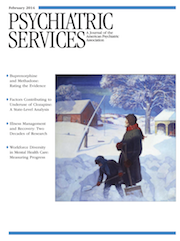Prevalence of Psychotic Symptoms: In Reply
In Reply: We greatly appreciate Mr. DeVylder’s thoughtful comments. Although we had vetted our analysis with the University of Michigan staff members who manage the CPES, the two methodological points that Mr. DeVylder identified were not recognized by them or us. With respect to the underweighting of the overall sample, it was difficult to determine to what extent it would have changed the results if the sample had been properly weighted. However, the fact that the missing persons were from the NCS-R study, which had a greater number of white respondents, suggests that the overall national lifetime prevalence of psychoses might be slightly lower if the missing persons had rates of psychoses similar to rates for the NCS-R white respondents who were included.
With respect to the second comment, Mr. DeVylder correctly notes that we had mistakenly assumed that persons who were missing the 12-month data should be coded as having no psychotic experiences. He presented revised data that corresponds to our reanalysis in which missing persons are excluded rather than coded as zero. The recalculated overall adjusted 12-month psychosis rate is now 2.8%, which is more consistent with rates in the literature, although it still remains on the lower end. Moreover, we reanalyzed the logistic regression analysis for the 12-month data and found that all variables that had been significantly associated with lifetime psychotic experiences in our original analysis remained significant (that is, being Latino, being black, lifetime prevalence of posttraumatic stress disorder, and higher lifetime distress). An additional variable—living in the South versus the West—was found to be significantly associated with reduced rates of psychotic experiences. We have posted a copy of the reanalysis as a data supplement to the original article.
Finally, at the request of the peer reviewers of the manuscript, we included the 12-month prevalence data in our revision, although we believed that this item had a number of deficiencies. We expressed our concern about this variable in the paper, and now Mr. DeVylder has identified some other differences between the 12-month and lifetime items. Thus the reader should use appropriate caution in interpreting the 12-month findings.



